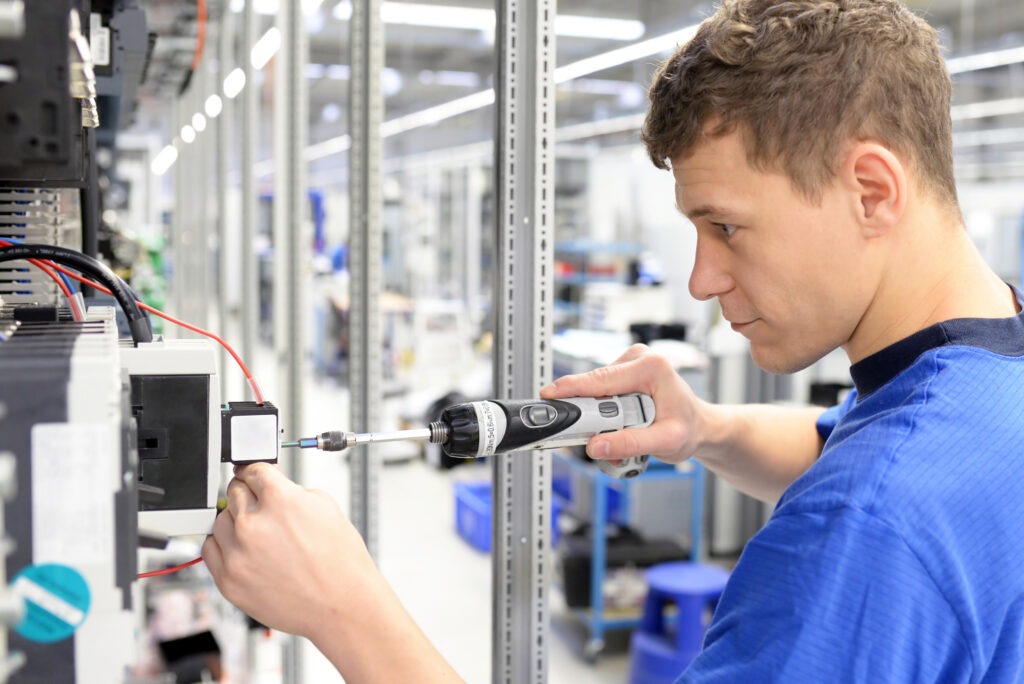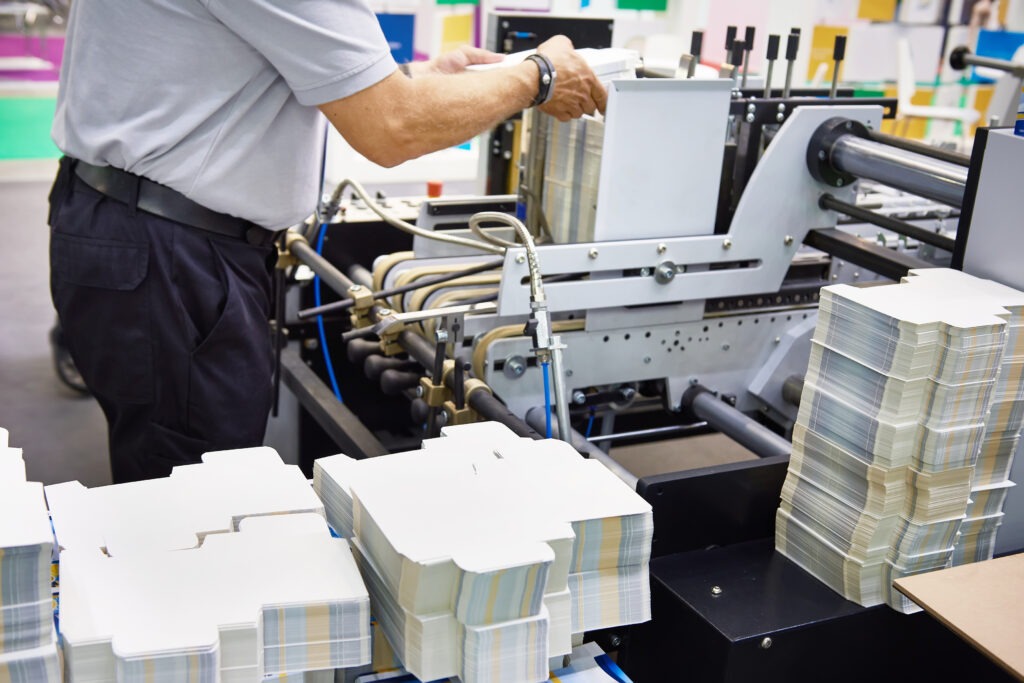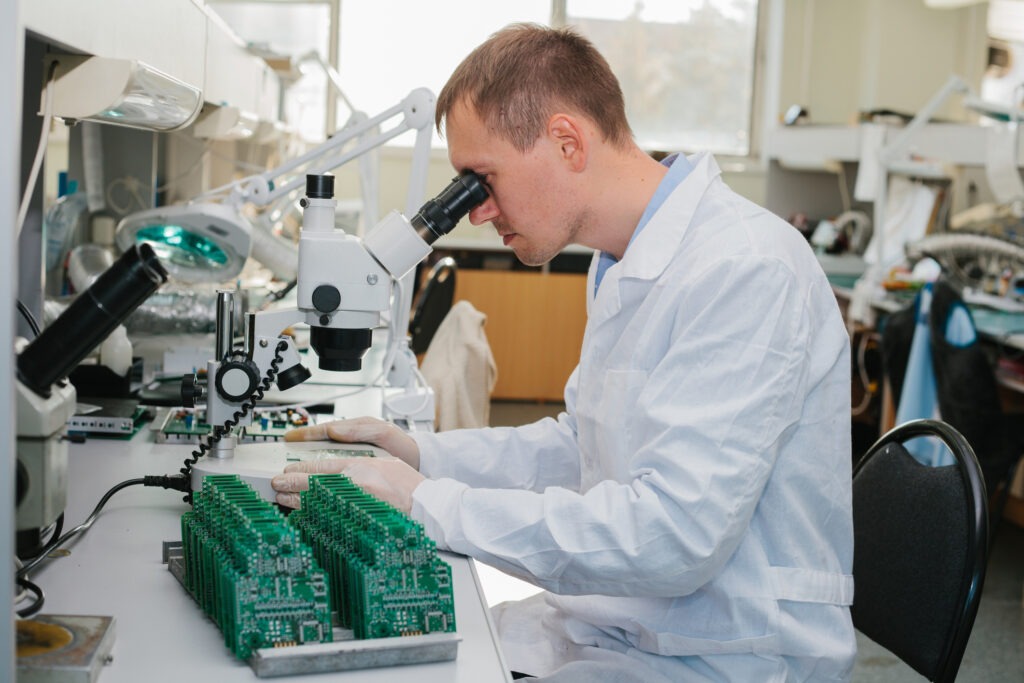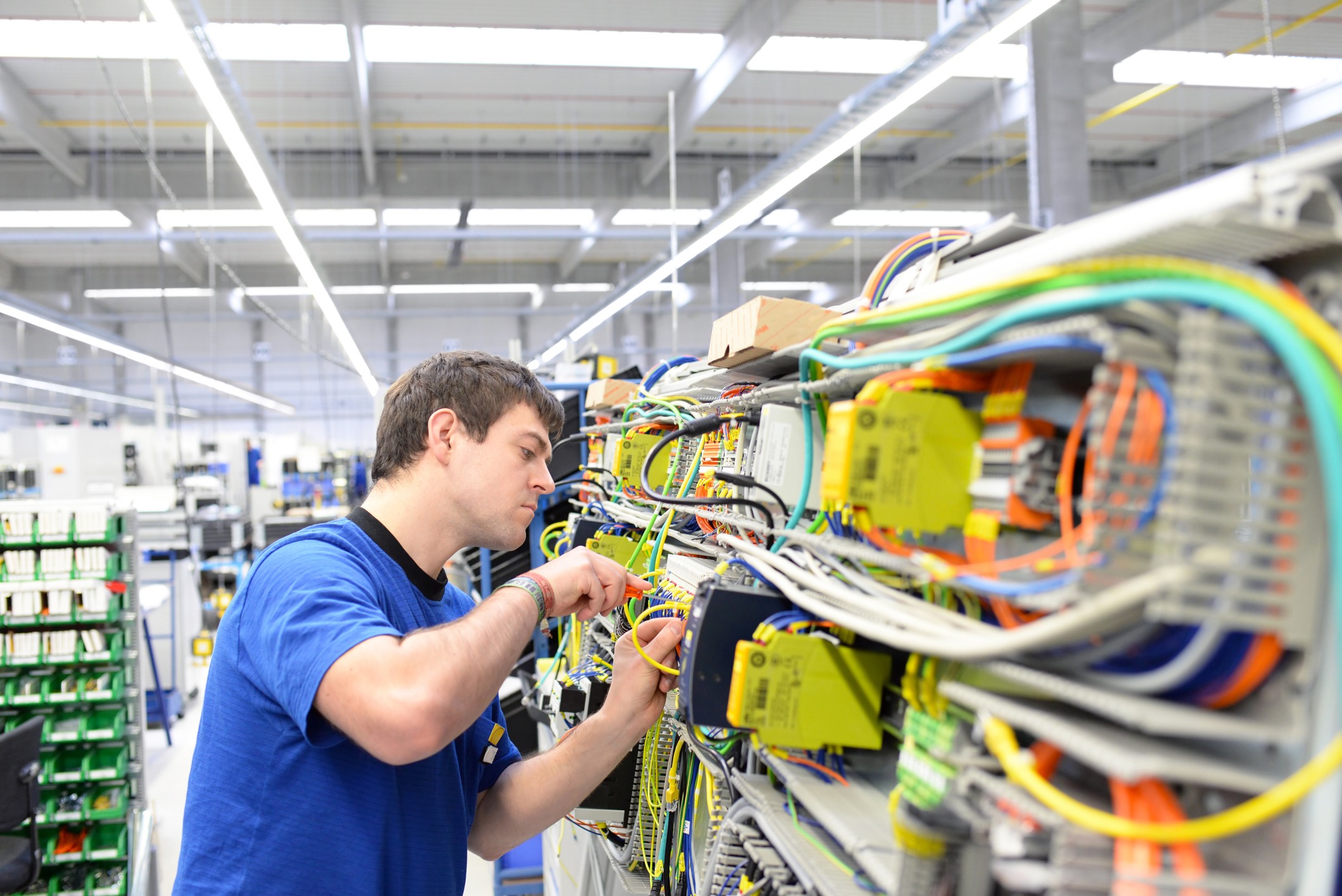How can production employees be deployed in the electrical industry?
The electrical industry developed with the industrial revolution that took place at the end of the 19th century. It is divided into two main areas. The first is electrical appliance manufacturing and the second is power supply. These areas are further subdivided into batteries, plant engineering, electric vehicles, batteries and much more.
In terms of the number of employees in the electrical industry, this industrial sector is the second largest industrial sector in Germany after mechanical and plant engineering. In 2020, its turnover amounted to 10 % of total industrial turnover in Germany.
Of course, this also means that there is a huge and varied field of activity for production employees. This begins with the operation of machines, continues with assembly and reaches its logical climax with logistics.
Table of contents
- How can production employees be deployed in the electrical industry?
- What are the tasks for production employees in the electrical industry?
- What is the difference between a production worker and a production assistant?
- What are the opportunities on the labour market as a production employee in the electrical industry?
- How is the safety of the manufactured devices guaranteed?
- What are the tasks of production employees in packaging and dispatch preparation in the electrical industry?
- What work is there for production employees in quality assurance in the electrical industry?
- Similar topics
Estimated reading time: 19 minutes
What are the tasks for production employees in the electricalindustry?
In the various areas of application, the factory workers are responsible for many different tasks. These differ in detail depending on the company and position, but there are also commonalities that can be generalised. This results in the following specific areas of responsibility:
- The Assembly: This is where production employees assemble components, parts, and circuits. This is done either at various stations or along assembly lines, either manually or with the use of machines.
- Operation of machines: Production is carried out using various machines and systems. These must be controlled and operated. They also need to be loaded, cleaned, and maintained.
- Quality control: Naturally, quality control must also be carried out in the electrical industry, especially since handling electricity involves significant risks. Accordingly, production employees must carry out careful inspections to ensure that materials comply with specifications, that production follows regulations, and that the products meet all requirements.
- Logistics: A warehouse is required for production. It must be stocked. Products need to be packaged, and the transport of goods and materials must be organised.
- Preparation: Production employees must prepare the various materials used in manufacturing. This includes cutting, punching, bending, or otherwise modifying them to reach the required condition for production.
- Cleaning: After the shift, work areas, tools, and machines must be cleaned. This is also part of the production employees’ responsibilities.
Where do the production employees work?
From this wide range of tasks, it is easy to see that the job of a production employee is very varied. They are employees of the company, helpers in production, and are needed in all areas. They support the manufacturing of goods, ensure safety in the factory, and contribute to customer satisfaction and safety.
Production workers are always active where machines and computers reach their limits in production. This makes them the flexible links between production steps. They also operate machines and computers and are therefore involved even where the systems themselves handle production.
They also prepare materials and pack the finished products. In between, they handle all the logistics related to warehousing and production, such as loading the machines.
What is the difference between a production worker and a production assistant?
In practice, the terms "production employee" and "production assistant" are often used interchangeably. However, there are differences between the two. For example, production assistants are usually unskilled workers who are responsible for simpler activities. However, when it comes to more complex tasks, such as the assembly of complicated objects, specialised training is often a prerequisite. This is then carried out by production employees with the appropriate qualifications. In addition to their training, they are usually also characterised by corresponding experience.

What are the requirements for working as a production employee in the electrical industry?
Generally speaking, production employees do not need any formal training. Even unskilled workers can easily be employed as production assistants or for simpler tasks in general. However, if you want to do more than just simple labour, you should have some manual dexterity and practical skills. It is even better if technical knowledge is available and relevant experience has already been gained in advance.
If these requirements are met, it is easier to familiarise yourself with the tasks involved. However, it is also possible to find a job without experience or training. In this case, however, it will take longer to familiarise yourself with the job, as the simplest tasks have to be carried out first. If these are completed satisfactorily, more advanced tasks can then be tackled.
Those who can demonstrate further training in the trades or industry have even better prospects. Careers and opportunities for advancement are available here. In addition, further training and specialisation increase both opportunities and salaries.
In the electrical industry, as elsewhere, production usually involves working in shifts. Accordingly, an employee in this field must also be flexible and able to work under pressure.
The work itself is also physically demanding. To cope with it, production employees must be in good physical condition. However, this also has its advantages: heavy workloads, night shifts, and rotating shifts often come with bonuses that are quickly reflected in your bank account.
What are the opportunities on the labour market as a production employee in the electrical industry?
Production workers are also in demand in the electrical industry. This applies both with and without a completed apprenticeship. Career changers are also welcome here. With an interest in technology and a certain basic understanding, it is usually easy to find a job.
This also requires a willingness to work in shifts and not to shy away from physical exertion. In addition, applicants must be able to work conscientiously and with an awareness of quality. Further knowledge, training, and specialisation also increase the chances of getting a job. They also have a positive influence on salary prospects.
How are production employees deployed in the assembly of electronic components?
The assembly of electronic components in particular is an important area of application for production employees. The exact deployment here depends on the type of components, the desired productivity, and the required quality. The work is organised accordingly. It can be carried out completely manually using tools or with the help of machines.
In manual assembly, the production employees prepare the assemblies according to the specifications and drawings. They then assemble them according to the instructions and make the necessary connections. This often requires the use of circuits. During preparation, they adjust the components accordingly and then insert them in such a way that they produce the desired circuits.
In machine assembly, assembly takes place within automated processes. Here, the production employees operate the machines. They load them or the machines that are intended for loading. They ensure that production runs smoothly. They also carry out the necessary maintenance work and make adjustments to the systems.
During ongoing production, they ensure that the manufactured products meet the required quality. They monitor the components and circuits that are completed. They check them for faults and rectify them where necessary. They also make new adjustments to the machines to avoid future errors.
What do the production employees do as part of quality control?
As part of quality control, they check the components and circuits. This includes visual inspections as well as functional checks. They monitor the processes and find ways to improve efficiency.
To be employed in assembly, production employees must have the necessary skills and knowledge. The exact requirements can be found in the respective job advertisement. The company also ensures that the employees entrusted with assembly have exactly the skills and knowledge required. This may also mean that, as part of the application process, candidates must prove that they can carry out the tasks as required.
How is the safety of the manufactured devices guaranteed?
The companies are responsible for ensuring that the finished devices meet all requirements. These result from statutory regulations and customer specifications. In plain terms, this means that the devices must be suitable for the intended and described use, as the customer expects. They must also be safe, as required by law.
To ensure that the finished devices pose no danger and meet the customer’s requirements, a final inspection is carried out at the end of production. Three test procedures are used: visual inspection, functional testing, and measurement. This ensures that the devices function properly and pose no safety risks even after delivery to the customer.
The inspection ensures proper functioning and safety. The aim is to identify all defects and faults that could later lead to negative consequences, such as accidents, fires, or electric shocks. Especially given the seriousness of such risks, appliance testing must be carried out extremely conscientiously. Another goal is to extend the service life of the devices and avoid costly failures.
How does the appliance test work?
The first step in the inspection process is a visual check. This involves identifying external damage that may indicate improper assembly or even accidents, such as components being dropped. If faults are already present at this stage and indicate too great a risk for the subsequent tests, the appliance is returned.
The second step is the functional test. This determines whether the devices are working correctly. The main aim here is to assess whether the products are suitable for the tasks intended by the customer.
Measurements are taken in the third step. This involves checking safety values such as protective conductor resistance, insulation resistance, and leakage current. The goal is to determine whether the devices can still be used safely at a later point. If minor deviations are found, it can indicate potential future risks and whether the device needs to be discarded.
The production employees who carry out the tests must meet certain requirements. This includes either being qualified as electricians or having acquired the relevant electrical knowledge through experience. In the latter case, the production employees work under the supervision of a qualified electrician.
The appliance test is essential following installation. It concerns user safety, identifying potential hazards, and complying with legal regulations. It can also help prevent or at least minimise claims for damages against the company.
What are the tasks of production employees in packaging and dispatch preparation in the electrical industry?
Packaging and preparation for dispatch are also very important work steps in the electrical industry. The primary goal is to ensure protection against external influences. This starts with preventing soiling and extends to protection against physical damage.
But that is by no means all. Damage can compromise user safety, and there is also the special risk of electrostatic discharge. The packaging must also provide protection against this.
This requires conscientious work in packaging and shipping preparation. Production staff must select appropriate packaging materials that offer sufficient protection and are preferably cost-effective. The parcels must also be correctly labelled, and the shipment secured.
Packaging therefore fulfils several functions that production employees must take into account:
- It must protect the contents from shocks, vibrations, and moisture. This applies to both transport and storage.
- ESD foams and films must be integrated into the packaging in such a way that they do not impair its protective function while effectively preventing static discharges, especially with sensitive electronics.
- The packaging must also serve a storage function. It must be designed to allow stacking and be appropriately sized to fit storage containers.
- Then there’s the presentation function: packaging should support the product’s appeal and, whenever possible, contribute to a positive purchase decision.

This results in several tasks for the production employees:
- First of all, they need to choose the right materials for the packaging. Depending on the case and device, this can be foam, plastic, cardboard, corrugated cardboard or even metal.
- Labels must be attached to ensure proper labelling. These must contain the correct information, including the recipient’s address, the supplier, the weight of the entire parcel and its volume.
- A securing mechanism is also required for the packaging, especially if the product inside is smaller than the interior of the packaging. It could otherwise shift and be damaged during transport. To prevent this, the production staff use filling materials. They may also use tape and stretch film to secure the goods inside the packaging.
- Depending on the weight and size of the consignment, it may also be necessary to palletise the parcels. This means stacking them on pallets and securing them there. This makes them easier to move later with forklift trucks or transport vehicles.
The production staff must also select the appropriate shipping method. This depends on the transport route, the urgency of the delivery and the requirements of the company and the customer.
What work is there for production employees in quality assurance in the electrical industry?
We have already mentioned quality assurance in connection with device inspection during production, but it also takes on other tasks for the production process as a whole. It is important to remember that it plays a particularly significant role in the electrical industry. The goal is to ensure that even non-professionals can use the manufactured devices safely and that they are suitable for their intended purposes.
Quality control must ensure that the goods meet safety standards and customer requirements. It also monitors processes to ensure that high quality is maintained at every stage and that no errors or carelessness go unnoticed.
To ensure this, quality control starts with the suppliers, continues throughout the production processes, and even includes the fully packaged end product. All of this serves to ensure safety, reliability, and customer satisfaction.
What are the core tasks in quality assurance?
The Temporary Supplier management is therefore the first core task of quality assurance. The employees check whether all materials and components arrive on time and in sufficient quantities. In quality control, they also ensure that the materials and components supplied are of the contractually agreed quality and are suitable for use in production.
In production, the production employees monitor the processes used to manufacture the parts and end products. In doing so, they ensure that all the materials and assemblies provided are fully processed. It is all about efficiency and therefore reducing costs. It is also important to recognise and reduce errors that can creep into the processes as early as possible. This also increases efficiency and ensures that the end products achieve the desired quality.
Another core task is testing product quality. For this purpose, production employees in quality control take samples and check whether they meet the specifications for each respective stage of production, both in terms of dimensions and functionality. Specific inspection standards are defined for each stage of production and used as reference points.
Ensuring the quality of the end product is another key task. A so-called final inspection is carried out to verify that the product meets customer specifications and expectations before it is packaged. Only then does the dispatch preparation begin.
Quality management is also a core element of quality assurance. This involves introducing systems that help ensure and streamline continuous quality control through the recording of all relevant data. The objective is to continuously improve both the quality itself and the methods used to control it.

Which methods and techniques are used for quality assurance?
Production employees use various methods and techniques for their quality assurance tasks:
- This begins with the inspection of deliveries. Components and materials are inspected visually, through measurements or, if necessary, via functional tests directly upon receipt. This is done either in full or on a random sampling basis.
- For process monitoring, there are clear descriptions and specifications that define how the processes must be carried out. In addition, there are quality control charts that allow easy comparison of actual production results with standards. The data can be analysed using statistical methods so that production staff can determine whether the processes are stable or whether adjustments are needed.
- Product testing is again carried out through visual inspections, measurements and functional tests. The gathered information is compared with the provided specifications and reference tables to assess whether the products meet the required standards.
Up to this point, the quality assurance work is relatively straightforward. Employees monitor the processes and record the resulting data for analysis. However, it becomes more complex when errors and deviations occur, at which point production employees are also responsible for reporting the issues and managing corrective actions.
How are the detected errors handled?
Errors and deviations are examined in more detail. It is essential to identify the root cause behind each issue. Based on this, measures can be proposed or initiated to prevent similar errors in the future.
As part of this process, quality assurance staff also play a role in training manufacturing and production employees. They develop training sessions based on their experiences and share the knowledge needed to improve efficiency and reduce waste.
Ultimately, the goals for quality assurance employees are clear: reduce rejects and complaints, improve product quality, and increase efficiency, either to boost productivity or reduce costs. They must also ensure compliance with relevant laws to avoid penalties or liability claims and to enhance user safety.
Conclusion
Production employees in the electrical industry have a wide range of responsibilities. These include operating machines (including setup, cleaning, and maintenance), loading equipment, preparing materials and components, cleaning workspaces, performing manual or machine-assisted assembly, packaging, dispatch preparation, and quality assurance.
They may take on more complex tasks, such as programming machines, or simpler ones as production assistants, such as tidying up. Production employees can work in factories without formal training, but many roles benefit from or require training, further education, or specialisation. These qualifications lead to better career prospects and higher pay.
Employees are also urgently needed in the electrical industry. This means that jobs can easily be found for unskilled workers and career changers. They can then easily get to work in assembly or in packaging and dispatch preparation, for example.
Quality assurance is also held to high standards. The use of electricity comes with inherent risks, which is why strict safety requirements must be met for the devices. In addition, customer specifications must also be fulfilled. To achieve this, the final products, the manufacturing processes, and the materials and components used are continuously monitored. This also serves to increase efficiency and reduce costs.
Similar topics



